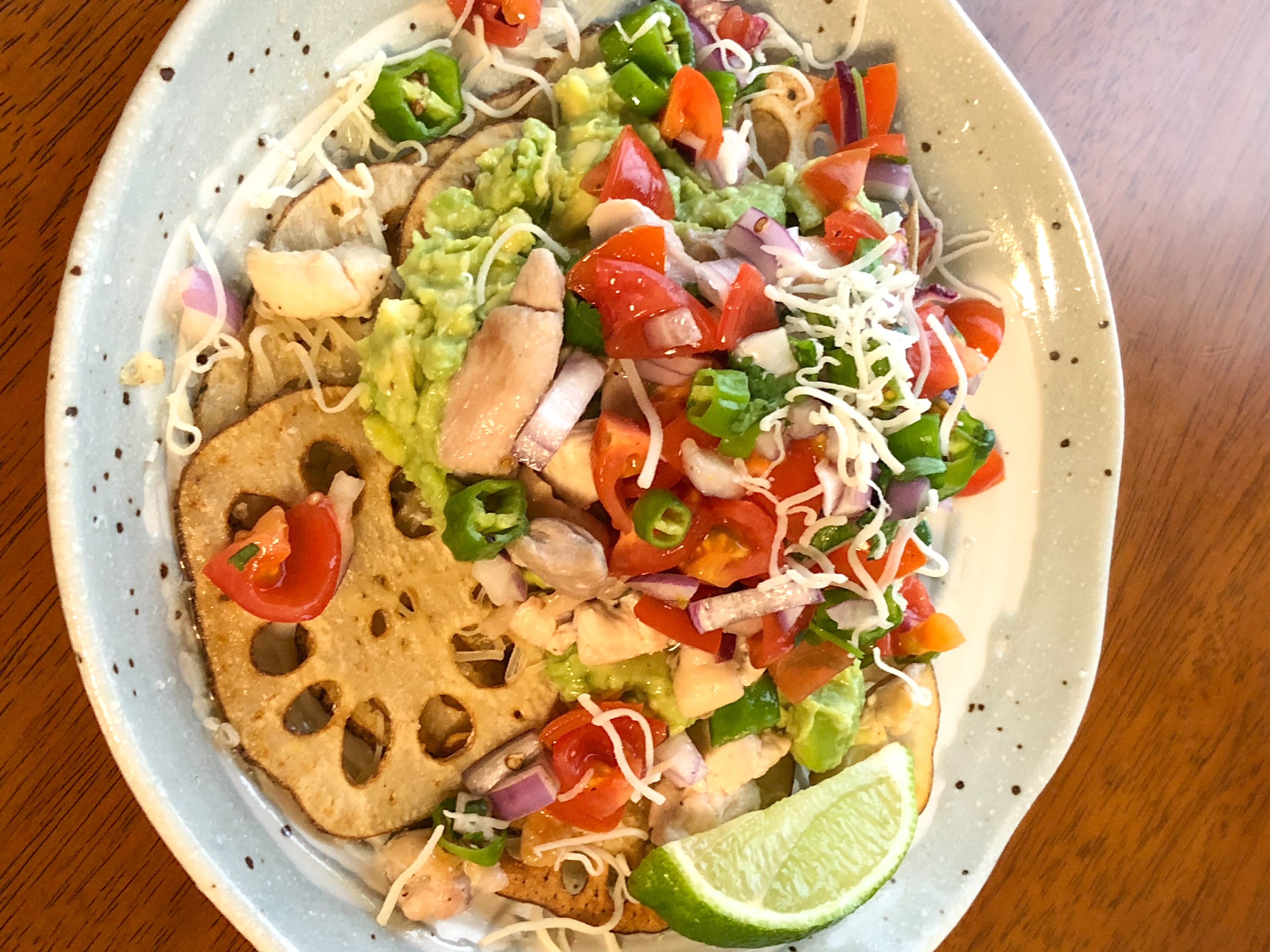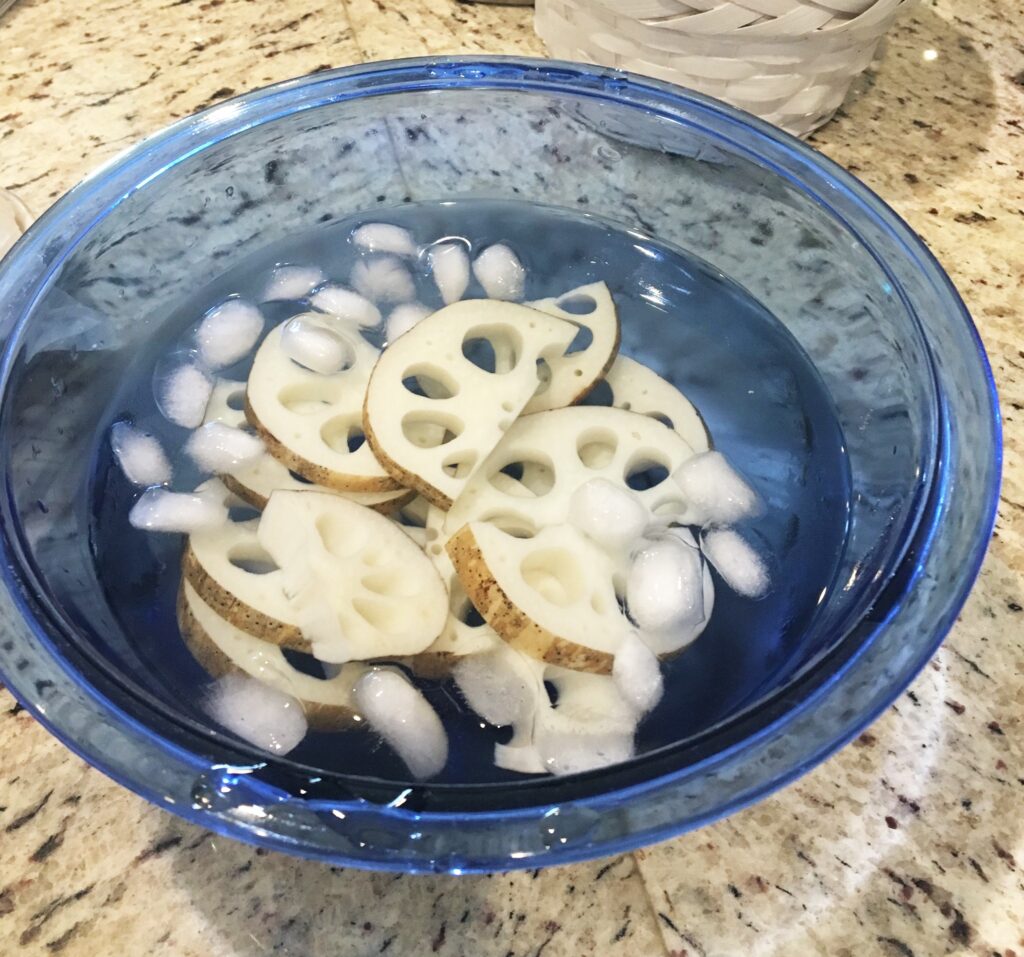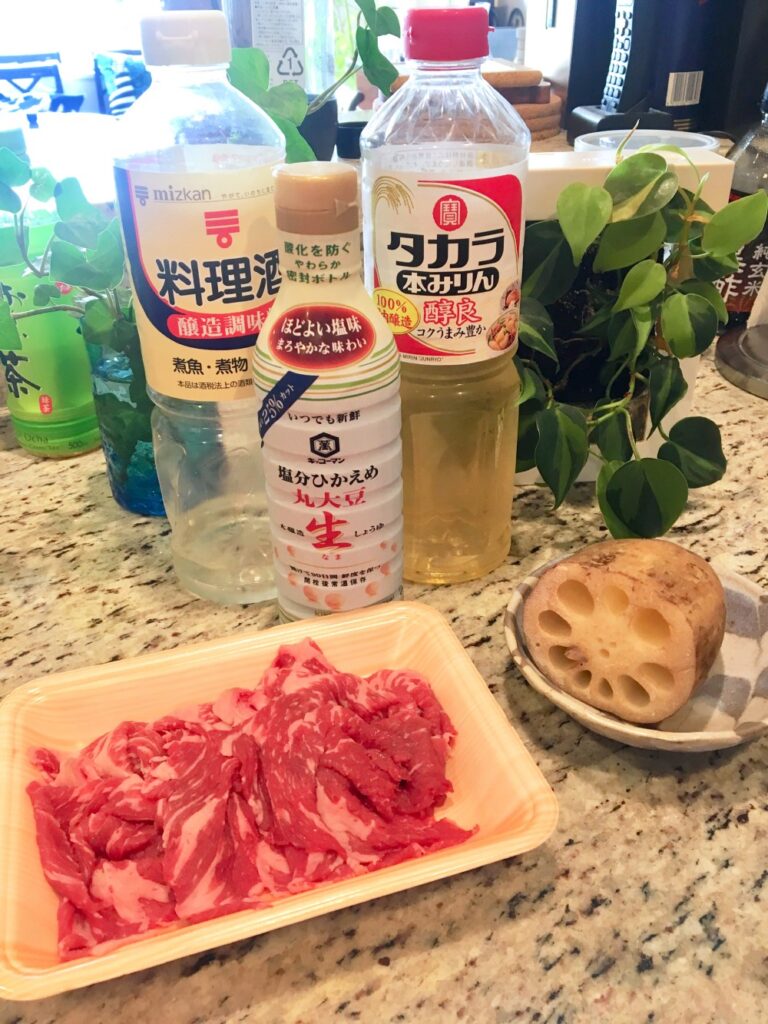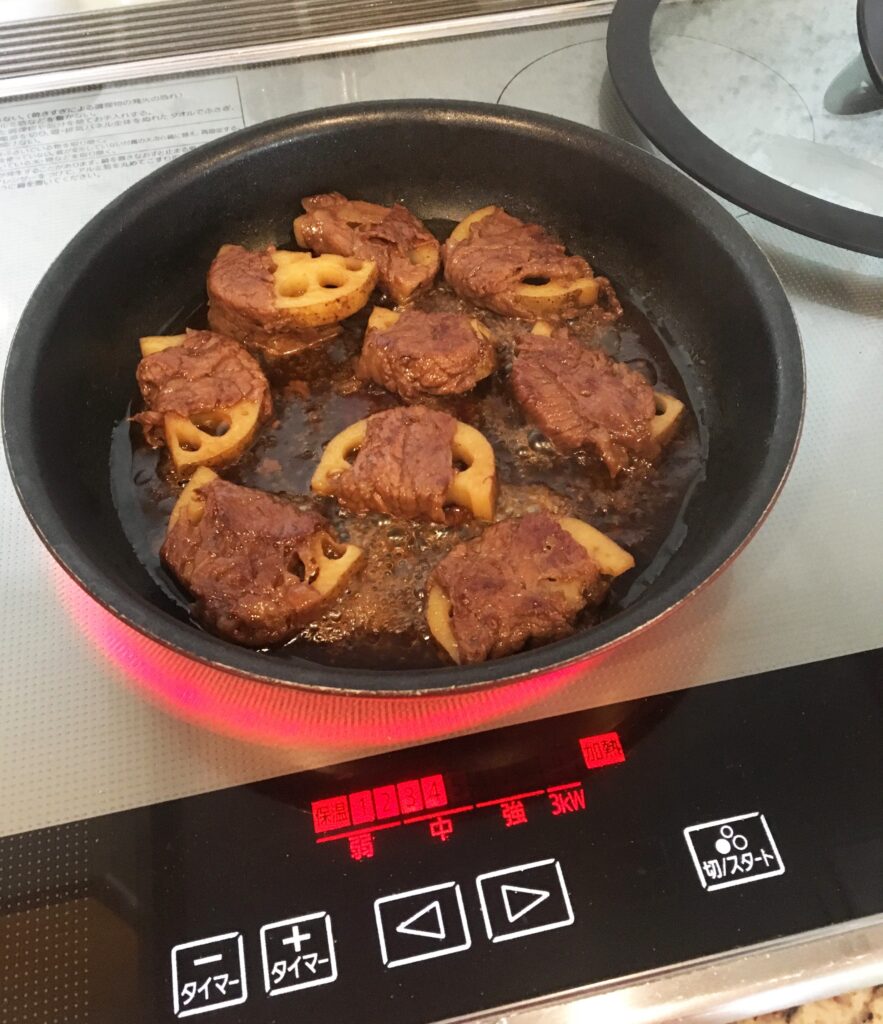This article originally featured in the February 2022 issue of Connect
Reignite your Love of Vegetables with the Lovely Lotus Root
Kaki Okumura
Dowdy whole, lovely sliced, the lotus root may be just what the doctor ordered to break you out of the winter food rut we all tend to feel this time of year.
I’m not here to tout lotus root as a superfood vegetable capable of solving all of our health woes. But incorporating a variety of nutritious and tasty vegetables into our meals is an essential part of a healthy diet. If you’ve become jaded by the vegetables available to you, don’t find them exciting anymore, or simply don’t enjoy them, some exposure to less commonly-known vegetables in unique flavor profiles may just be what you need to ignite your love for plant-based whole foods again. Because while there is such a wide variety of vegetables in the world, our exposure has become very limited. So why don’t we try opening those doors again?
Lotus root (or “renkon” in Japanese) is the bottom, edible part of the lotus plant. It’s crunchy, mild, and similar in flavor and texture to a raw potato. For centuries, lotus root has been used in East Asian cuisines, particularly in Japanese and Chinese cultures. Lotus root is a versatile ingredient that can be used in several different ways. It can be deep-fried, stir-fried, braised, or steamed. It is also commonly used in traditional herbal medicines in dried and powdered form.
Lotus root is full of important nutrients, minerals, and vitamins. It’s an excellent source of fiber, which is important to regulate our blood sugar, improve digestion, and manage our appetite. It is also a great source of vitamin C, a powerful antioxidant. Vitamin C is essential for maintaining a healthy immune system, keeping our blood vessels clean, producing collagen, and maintaining our organ and bone health. Lotus root also has a high iron and copper content, which is essential for red blood cell production and can be a great addition for people who may deal with iron deficiency anemia, a common source of headache and fatigue. (1)
While lotus root is a starch, its calorie content is moderate compared to other root vegetables at about 75 calories per 100 grams. (1) So calorie-conscious individuals will find lotus root to be in line with their goals while providing lots of nutrients and fiber to keep them feeling full.
In this month’s issue, we’ve included some of our favorite and exciting ways to enjoy lotus root—pan-fried and wrapped in beef in a sweet-salty soy sauce glaze and loaded lotus root chicken nachos! Hopefully, with these two mouth-watering dishes, you’ll be able to convince even your most vegetable-averse friends to give the lotus root a try.
References:
Beef-Wrapped Lotus Root in a Sweet-Salty Soy Sauce Glaze
Kaki Okumura

To choose a healthy root for eating, make sure it feels heavy and firm. The color should be pale to indicate freshness and be free from any bruises or cracks. To ensure the best taste, we need to choose the best ingredients.
Ingredients
- 200 grams (about a half-pound) lotus root
- 200 grams (about a half-pound) thinly-sliced beef
- 3 tablespoons soy sauce
- 3 tablespoons mirin
- 3 tablespoons cooking sake
- 2 tablespoons sugar
- Pat of butter (or oil of choice) for the pan
Instructions
- Peel the lotus if you choose. (It’s relatively thin and doesn’t make a huge difference, but the outside skin may feel a bit tough if kept on.) Rinse and cut the lotus root into moon-shaped discs and then put it in an ice-water bath for about five to ten minutes. This prevents oxidation to preserve the crunchiness and removes compounds that cause bitterness.
- Boil water and blanch the lotus root for 1-2 minutes. Be careful not to overboil! Left in too long, it will become a soggy mess.
- Remove lotus root, let cool. Then, take the thinly-sliced beef and wrap it around the lotus slices.
- Heat up a pan to medium-high heat and melt butter or oil. Cook until the outside is looking browned, about 2-3 minutes on each side. (More flavor is brought out when it’s browned! This is not essential but makes a difference in my opinion).
- Reduce to low heat. Add soy sauce, mirin, cooking sake, and sugar evenly over the pan.
- Flip lotus root wraps several times until the sauce is incorporated into the beef and lotus root. At this point, the sauce should be simmering a bit so it reduces and thickens.
- Remove the lotus root wraps from the pan and place onto a plate. Leave the sauce for a bit longer, until it reduces to a thick consistency.
- Pour the sauce over the lotus root wraps and enjoy!
Kaki Okumura is a Japanese food and wellness writer helping others discover simple ways to approach food, movement, and rest so they can reach higher levels of lifestyle balance and, ultimately, contentment. To read more of her writing, please check out her website, blog, and Instagram account!
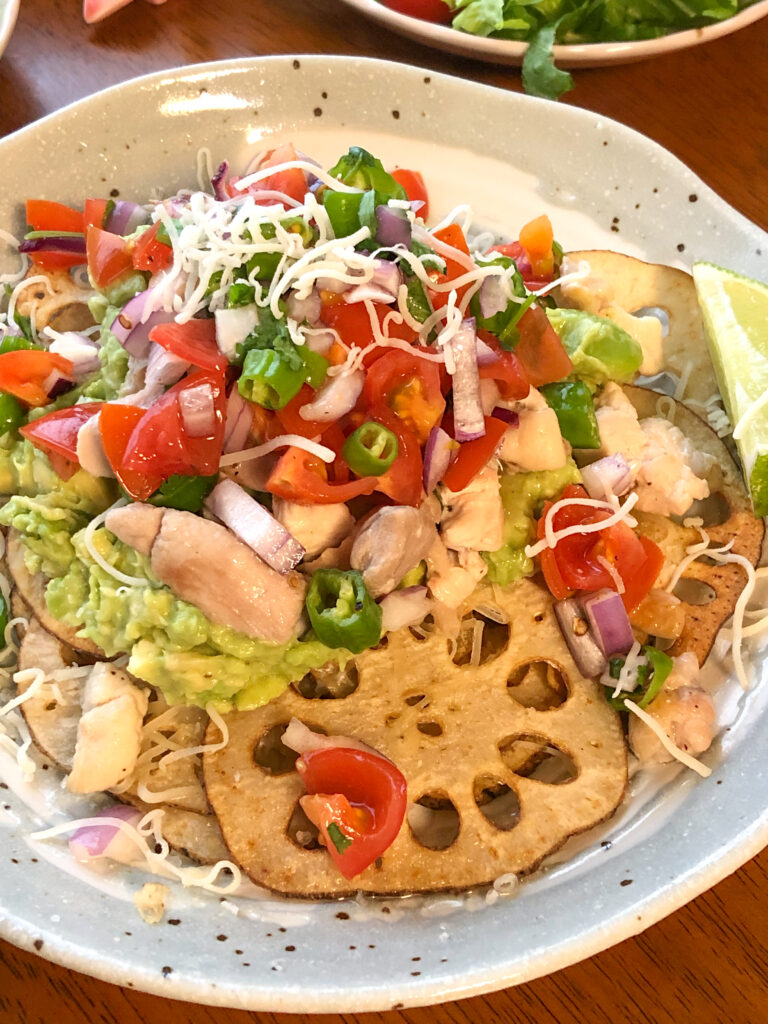 Lotus Root Chicken Nachos
Lotus Root Chicken Nachos
Kaya Zepeda (Niigata)
Having a hard time finding nachos in Japan? With these lotus root chips, you’ll be able to make delicious nachos in the comfort of your own home!
All the seasoning in the recipe is approximate, so please season to your desired taste.
Ingredients
1 renkon (lotus root)—A 5 cm wide by 7 cm long lotus root was used for this recipe, but any size will do! The longer the root, the more chips you can make!
Pico de Gallo
1/2 red onion
1/2 red tomato
6-8 cilantro stems
1 jalapeño
1.5-2 limes
0.5 grams (0.02 ounces) garlic powder
0.5 grams (0.02 ounces) salt
0.5 grams (0.02 ounces) pepper
Guacamole
1 avocado
1.5 grams (0.05 ounces) salt
Nachos
2 skinless chicken breasts
1.5 grams (0.05 ounces) garlic powder
2.5 grams (0.09 ounces) salt
1 gram (0.04 ounces) pepper
extra virgin olive oil (for oiling the pan)
1 renkon (lotus root)—A 5 cm wide by 7 cm long lotus root was used for this recipe, but any size will do! The longer the root, the more chips you can make!
500 ml (16.9 ounces) canola or vegetable oil
200 grams (7.05 ounces) shredded cheese (Any cheese is okay!)
First, prep the pico de gallo and guacamole.
Pico de Gallo Instructions
- Dice the red onion and tomato into small cubes. Place in a medium-size mixing bowl.
- Finely chop the cilantro. Add to the bowl with the onions and tomatoes.
- Slice the jalapeño pepper in half (going down lengthwise/vertically) and remove the core and seeds. Then dice the pepper into small pieces and add to the bowl.
- Halve the limes and squeeze the lime juice into the bowl.
- Add a pinch (about 0.5 grams) of garlic powder, salt, and pepper.
- Mix all the ingredients together and put in the fridge while you prepare the other components.
Guacamole Instructions
- Remove the avocado pit and scoop both sides of the avocado with a spoon into a bowl.
- Add 1.5 grams of salt to the bowl.
- Smash the avocado with a fork until you reach your desired consistency.
- Place the guacamole in the fridge.
Next, prepare the chicken!
Lotus Root Chicken Nachos Instructions
- Season both sides of your chicken breasts with the remaining garlic, salt, and pepper.
- Cut both the chicken breasts into bite-sized pieces.
- Add a swirl of extra virgin olive oil to a pan and set it to medium-high heat.
- Once the pan has heated for about one minute, add your cut-up chicken. Cook the chicken on each side for about two and a half to three minutes. Per the U.S. Department of Agriculture, poultry is ready once it reaches the minimum internal temperature of 165°F (73.9°C).
- After the chicken is done cooking, set it aside to rest while you prepare the lotus root.
- Now, it’s lotus root time! Rinse the lotus root with water and thinly slice it width-wise so that you are able to see the natural flower-like pattern. The slices should be about 2-4 mm wide. Alternatively, you can use a mandolin to slice the lotus root if available.
- Pat the lotus root “chips” dry with a paper towel.
- In a frying pan or pot, heat up 500 ml of canola oil or vegetable oil over medium-high heat. Your oil is ready when you put a tiny piece of the lotus root into the oil and it automatically bubbles up and floats to the surface.
- Add six to eight pieces of sliced lotus root at a time into the oil. Fry for two to three minutes until golden brown/dark brown (depending on how crispy you want your chips), then remove the lotus root chips and add to a plate with a paper towel. The paper towel is used to absorb any excess oil.
- Add a handful of your shredded cheese to the lotus root chips. The heat from the chips should melt the cheese. Every time you fry more lotus root chips, add more cheese.
- After the cheese has melted on the lotus root chips, add your guacamole, pico de gallo, and chicken!
- You have now successfully made Lotus Root Chicken Nachos! Enjoy!
Kaya Zepeda is a first-year ALT out in the Niigata countryside vibing, thriving, and surviving. She is manifesting a life full of laughs and good times.




